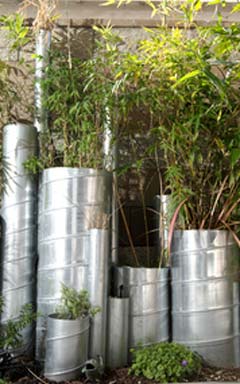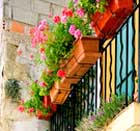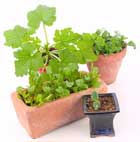- Gardening Tips |
- | What's NEW! |
- | Contact Us |
- | Sitemap
Container Gardening Tip
Our container gardening tip featured on this page is aimed at using big containers that make a design statement without the disadvantages that may go with it.

A Weighty Decision
Filling a large and/or deep pot with potting soil can be a bit expensive as well as heavy and doing so may be totally unnecessary.
If you intend using plants that do not require deep soil for their roots, then you can replace a large portion of the soil with another material. This is what we do:
- Fill the bottom section of the pot with a bulk filler that gives you volume, without the added weight.
For example, you could fill the bottom part of your pot with empty plastic containers - make sure you tightly close the caps.
We've used leftover bark chips on occasion (that you would normally use for mulching) to fill half the plant container.
You could use any material really - e.g. polystyrene is even lighter than wood chips - that would not degrade or compress too much with time. - Next we placed a plastic shade-cloth cut a bit bigger than the filler area. We used quite a dense weave - the idea being to stop the planting soil and roots, but not the water, from filtering through to the filler section below.
- Only then did we start filling our planting space with our rich potting soil, tamping it down layer by layer to compress the filler material. There may be some subsiding with time, but you would have had that anyway if you'd filled the whole container with potting soil.
If you can reduce the weight of your container, it also just makes it so much easier to move when you need to.
You can follow the same container gardening tip when you want to arrange smaller containers within a large or wider container. Here especially there is no need to fill a big pot with soil.
There are several advantages to using individual containers within a bigger one:
- It's easy to remove plants that either overgrow their space or who don't thrive;
- It's easy to water or feed plants individually, tailored to their needs;
- It's easy to change the composition of your arrangement for example: You can bring in plants during their flowering phase and remove them once flowering is finished or exchange upright specimens for cascading ones for a change...
- You can contain roots of plants that may become invasive and strangle those of other plants.
We all want container plants that look their best at all times. That may mean replacing them from time to time and this is where we hope our container gardening tip will come in handy for you!
Related Content:
To Top of this Container Gardening Tip page
Return to Gardening Tips Home Page
Gardening Updates
Note: We'd love you to send us your favorite flower gardening in containers ideas and pics to feature on our new pages!
Contact Us and we'll send you an email address that can accommodate your photographs.

